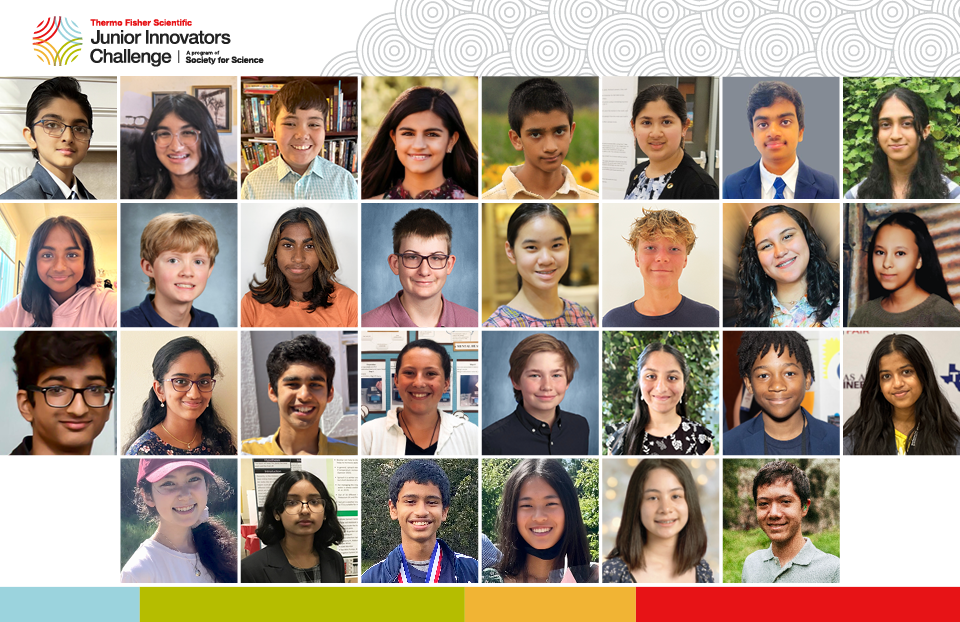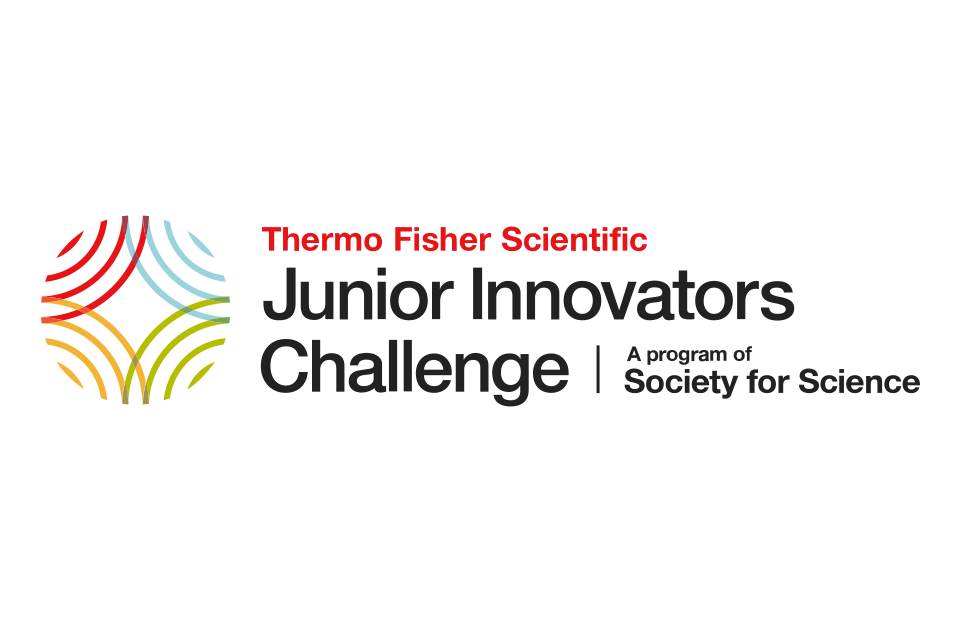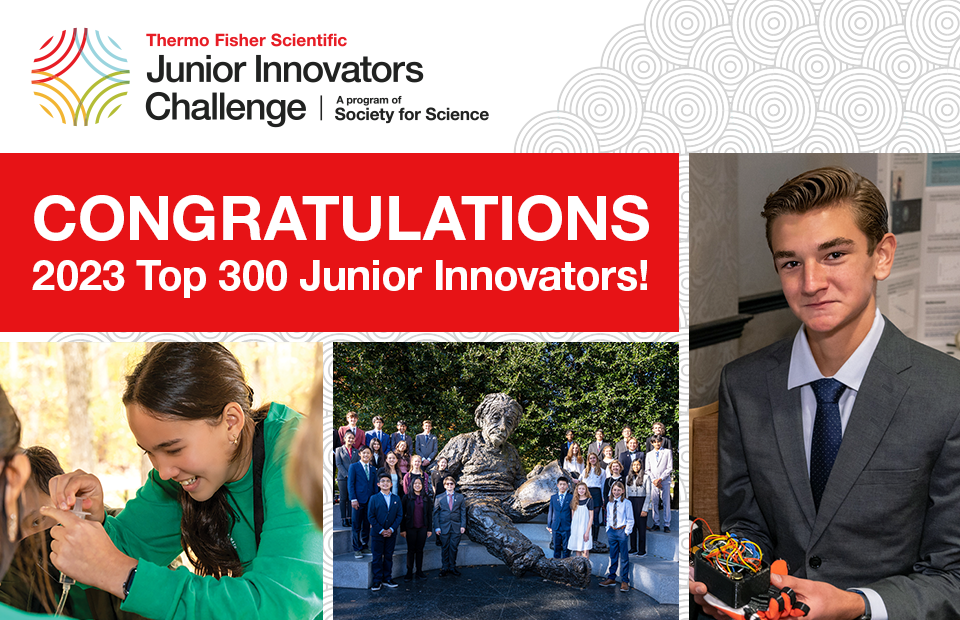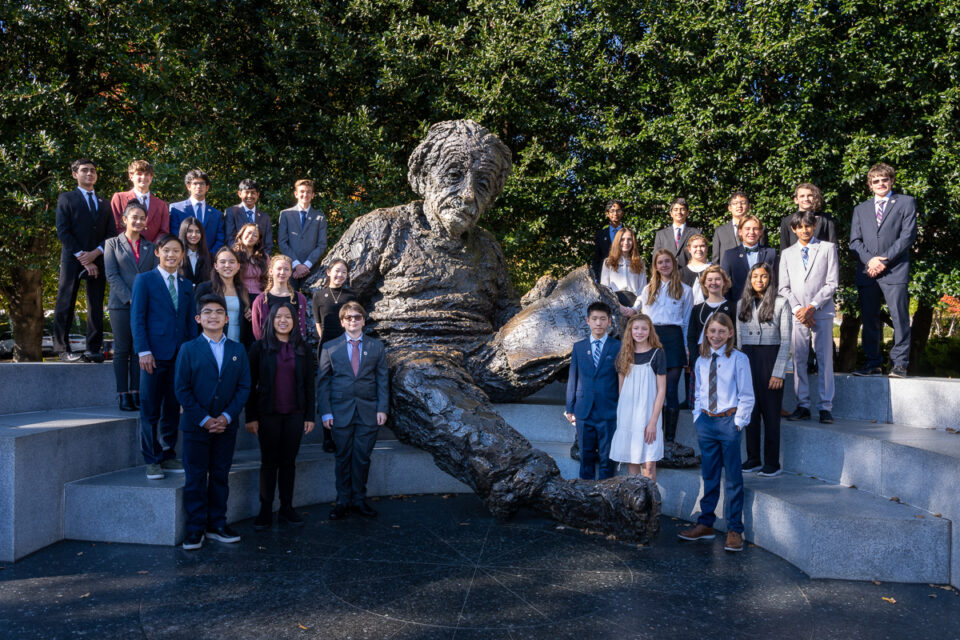2023 Thermo Fisher Scientific Junior Innovators Challenge Finalists
Society for Science and Thermo Fisher Scientific are proud to announce the 30 finalists in the 2023 Thermo Fisher Scientific Junior Innovators Challenge — the nation’s premier STEM research competition for middle school students. The finalists will travel to Washington, DC from October 28 – November 2 to participate in the Finals Week of the competition. Each student will be judged on both their science research projects as well as their demonstration of collaboration and critical thinking skills during team challenges, emphasizing the importance and value of teamwork in STEM fields.
All finalists receive a $500 cash award and will compete for over $100,000 in prizes.
View the Press ReleaseMeet the 2023 Finalists!
Inika Adapala
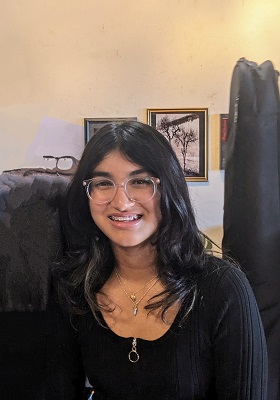
7th Grade, Stratford Middle School – San Jose
San Jose, CA
Communication App for Patients With Locked-in Syndrome
Project Background: Inika recently read an article about a man who recovered from locked-in syndrome (LIS). “Despite being fully conscious and aware of his surroundings, he was unable to communicate with his family or any of the nurses or doctors,” she says. People with this rare neurological disorder retain their cognitive functions, but movement is usually limited to eyeblinks and moving their eyes around. So Inika developed a smartphone app that tracks eyeblinks to help people with LIS communicate.
Tactics and Results: Inika first got a computer program to find a user’s eyes and detect blinks via a smartphone’s front-facing camera. It does this by locating a person’s nose and calculating where the top and bottom of their eyes should be. Inika then programmed her software to count a user’s blinks and tell if a blink lasted longer than 1 second. She connected this to a smartphone app she built with a library of phrases that a person might want to say. A person can use eyeblinks to navigate through the phrases, which are organized by category. A long blink confirms which phrase the user wants to say, which gets read aloud by the phone. Inika hopes that someday her app “will significantly improve the quality of life of patients suffering from LIS by providing them with a voice.”
Other interests: Inika enjoys piano and swimming. In the future, she hopes to become a medical doctor. “It allows me to follow my passion for helping others and making a real impact on people’s lives,” she says. “I love problem solving in a methodical way, and I believe that being a doctor would give me the chance to face new challenges that may arise and always keep learning.”
Jamie Kyle Ashby
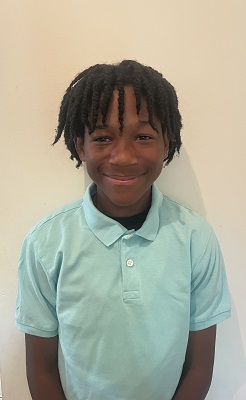
8th Grade, Booker T. Washington Middle School
Newport News, VA
Skin in the Game: Diagnosing Skin Conditions and Bug Bites on a Cell Phone Using Machine Learning
Project Background: “Any time I had a skin rash or bug bite, my aunt would claim it was ringworm, regardless of if it actually was ringworm,” Jamie says. But what if there was a system that could identify various skin conditions, he wondered. He previously used machine learning to train a program to tell the difference between cattle and sheep, so Jamie decided to make a smartphone app called Skin in the Game that could do the same for different skin conditions and bug bites.
Tactics and Results: Jamie collected lots of photos of bug bites, including those from spiders, mosquitoes and ticks. He also found photos of skin conditions like eczema, acne and ringworm. Using these, he taught a machine learning algorithm to recognize the different types of bug bites and skin problems. Jamie designed the app so that a person can take a photo of their skin, which gets analyzed by the algorithm. Then, the screen shows the name of the bite or condition, and the percentage of how closely the picture matches the diagnosis. In testing with new photos, Jamie’s app correctly identified most of the bites and conditions at least 75% of the time. “Skin in the Game is an effective, portable, low-cost tool for diagnosing various bug bites,” he says. “It could save users time and money by quickly identifying many skin problems.”
Other interests: Jamie enjoys playing violin, skateboarding, soccer and gaming. “Gaming is the way that my friends and I connect after school and immerse ourselves in different worlds,” he says. He hopes to create video games in the future as a software developer. “The market for VR and immersive games is growing, and I want to participate,” Jamie notes.
Advait Badrish
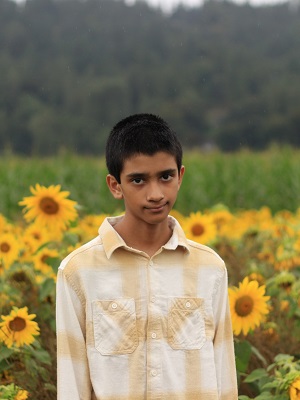
7th Grade, Redmond Middle School
Redmond, WA
HeartNN: A High-Accuracy Neural Network for Cardiac Auscultation
Project Background: “Cardiac disease is extremely common, yet often goes undetected,” Advait says. He wondered if people with heart problems could live longer with the help of artificial intelligence, specifically machine learning. “Doctors manually classify heart sounds as normal or abnormal using stethoscopes,” Advait says. “But what if machines could do the same?” He had coded his first machine learning project last year, so he wanted to apply the same concept to this health problem. Advait created a smartphone app that lets people check their heart sounds.
Tactics and Results: Advait collected audio recordings of heart sounds labelled as normal or abnormal from a publicly available dataset. He then converted the recordings into visual images that show how the sounds change over time, called spectrograms. Using these, Advait designed computer software that can classify visualized heart sounds as normal or abnormal. After testing the software on recordings that it had never analyzed before, it ended up being almost 98% accurate. Advait put the software to use in a smartphone app called HeartNN. A user simply uploads an audio recording of their heart sounds to be examined by the software. After getting analyzed, the app shows the probability of the heart sounds being normal. If something seems off, the user can follow up with a doctor. “This app empowers people to perform initial cardiac auscultation [listening to sounds from the heart or other organs] from the comfort of their homes,” Advait says.
Other interests: “I like playing video games,” Advait says. “Minecraft gives me access to a world where I can build what I want.” He also enjoys the game GeoGuessr, where he must figure out the location of a randomly-shown place by examining various landmarks. On the musical side, Advait plays the mridangam, a percussion instrument that originates from India. One day, Advait would like to be a computer scientist. “A career as a computer scientist will give me a lot of opportunities to showcase my capabilities and also develop technologies that can practically impact the world around me,” he says.
Colin Beckner
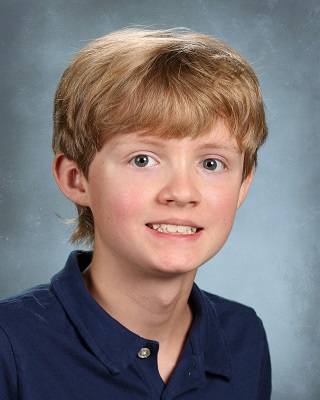
8th Grade, Swanson Middle School
Arlington, VA
Need a Lift? The Effect of a Wingtip Style on a Wing’s Percent Change in Weight When Run Through a Wind Tunnel
Project Background: Two years ago, Colin attended an aerospace engineering summer camp, which sparked his interest in airplane wing designs. There, he learned how airplanes work, and how to test the performance of their wing shapes in a wind tunnel. After that, Colin paid attention to the planes every time he was at an airport. “One thing I noticed was that some airplane wings had different designs of wingtips, and I wondered why,” he says. At the end of many airplane wings are smaller winglets that curve up or down, so Colin decided to test how different winglet designs could affect an airplane’s flight performance. “Winglets on an airplane can increase lift and reduce drag,” Colin says. “This results in the airplane burning less fossil fuel.”
Tactics and Results: Colin first designed a basic model airplane wing and 3D printed five copies. He then printed four different winglet designs to test and attached them to the ends of the wings. One wing was left bare. To test the designs, Colin constructed a small wind tunnel from cardboard, plexiglass and a fan. He placed a kitchen scale inside the wind tunnel to weigh the wings with and without the fan turned on. After conducting 10 trials for each wing design, Colin found that the Split Scimitar winglet had the biggest change in weight with wind. This winglet has two tiny wings, one slanting upward and one slanting downward. On average, the model wing’s weight dropped by 4.4 percent when the fan was on. “The Split Scimitar winglet would likely perform the best at generating lift and countering drag,” Colin says.
Other interests: Colin enjoys swimming, learning Latin and participating in Boy Scouts. “I like Boy Scouts because it introduces me to many new things, such as orienteering and rock climbing,” he says. “It has also given me a greater respect for nature.” Colin hopes to continue learning about airplane physics and designing structures as an aeronautical engineer.
Krishna Bhatt
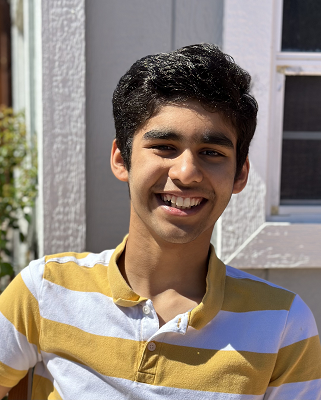
8th Grade, BASIS Independent Silicon Valley
San Jose, CA
A Novel Wearable for Active Prevention of Falls Through GRU-Based Gyroscopic Inference and Center of Mass Manipulation
Project Background: Krishna’s grandma has Parkinson’s disease. It’s a nervous system disorder that causes movement and balance issues. “Throughout her life, she has endured many falls, many of which resulted in injury,” Krishna says. He was sad to see his grandma lose her independence due to the disease. “She used to be an energetic lady,” he says. “Seeing her in this state hurts me.” Since Krishna is interested in electronics, he decided to create a device that could help people with balance problems.
Tactics and Results: Krishna designed a prototype balancing device that resembles a vest. It contains a gyroscope to detect how far its wearer is leaning. Based on that information, the system moves 1.8-kilogram, nearly 4-pound, weights hanging on either side of the user. Motors rotate the weights, raising them to be either in front of or behind the wearer. Doing so adjusts their center of mass, or balance point, to help prevent them from falling. Krishna tested the device’s effectiveness by leaning forward and backward at different angles with and without the vest. While wearing his prototype, Krishna had a 70.5 percent higher success rate of not falling compared to not wearing it. This device could one day help users gain independence and a higher quality of life, he says.
Other interests: Krishna has many hobbies, including swimming, Kung Fu, student council and violin. But his favorite is playing guitar. “It serves as an outlet of creativity for me, as I enjoy stringing together new melodies,” he says. He hopes to become a biomedical engineer so he can use engineering and technology to help people and improve healthcare.
Adyant Bhavsar
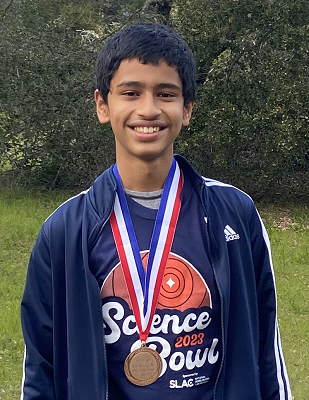
7th Grade, Challenger School – Strawberry Park
San Jose, CA
From Waste to Wattage: Converting Wasted Mechanical Energy Into Electricity Through Triboelectrification and Electrostatic Induction
Project Background: Throughout Adyant’s home state of California, there are hundreds of cameras and sensors set up to monitor wildfires and other disasters. “This got me thinking,” he says, “that to increase the reliability, these devices would need a sustainable energy supply that does not need frequent recharging or replacing.” So he looked up renewable energy sources until he came across one called a triboelectric nanogenerator. This device converts mechanical energy into electricity. When two thin, touching objects separate or slide against one another, electrons transfer between them, causing an electric charge.
Tactics and Results: To build his own triboelectric nanogenerator, Adyant sandwiched together two wooden planks separated by springs. Each plank held layers of different material pairings connected to electrodes. Those material pairings included glass with Teflon, Kapton with human hair, wool with PVC, and paper with cotton. For each variable set, Adyant completed five trials by pressing the top plank down to make the material layers touch. When the materials touched then separated, they transferred electrons to one another, producing an induced current. Adyant also tested three different surface areas for each material layer pair. He found that Kapton, a film used in electronics, paired with human hair produced the most electricity, and increasing the surface area with all materials increased the electrical output linearly. Finally, Adyant included a capacitator in the circuit to store the generated electric charge and was able to store enough charge to power a 1.79-volt light-emitting diode, or LED. “This triboelectric nanogenerator is lightweight, low-cost, eco-friendly and customizable,” Adyant says.
Other interests: Adyant enjoys reading, writing, piano, basketball, tennis, speech and debate. He’s won several writing awards and has published two fictional story books. “These hobbies enable me to express myself, gain diverse perspectives, and positively influence others with my ideas,” Adyant says. He hopes to become an environmental engineer. “I want to contribute my skills toward finding solutions for environmental challenges, such as deforestation and pollution,” he says.
Pranavi Chatrathi
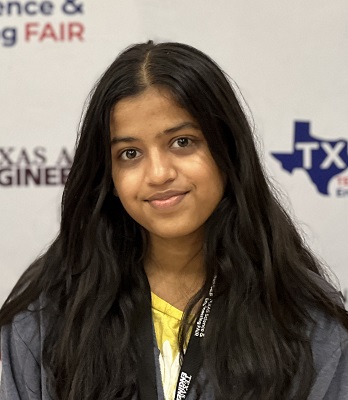
7th Grade, Pioneer Heritage Middle School
Frisco, TX
Side Impact Car Crash: An External Airbag To Reduce Injury Severity Through Reduction in B. Pillar Intrusion
Project Background: Pranavi’s parents were in a car crash when her mom was pregnant with her. “My grandparents constantly remind me that the three of us were lucky to have escaped the accident without any injuries,” she says. The constant retelling of this story has stuck with Pranavi. So, she checked out the National Highway Traffic Safety Administration website and research on car safety. She found that side-impact car crashes are some of the deadliest. After that, Pranavi says, “the concept of external airbags came easily to me.” She decided to design airbags on the outside of cars that could help reduce fatalities.
Tactics and Results: To reduce severity of injuries from side-impact car crashes, manufacturers need to reduce how far the pillar between the front and rear doors gets bent inward during an accident, Pranavi says. She simulated T-bone crashes using a gaming simulation software called BeamNG. In the software, she modeled how three different car models would fare if they had external airbags on their sides. Theoretically, these would be attached to the roof rails and be triggered by cameras monitoring other cars. Across all simulations, external airbags decreased the amount the car pillars bent when hit. With sedans and SUVs hit by cars moving 60 or 80 miles per hour, pillar bending was reduced, on average, 78 percent compared to simulations with no external airbags. “This project demonstrates the merit of adding external airbags in side-impact collisions,” Pranavi says. But the ultimate goal, she notes, is to build a real-life system that can make cars safer.
Other interests: Pranavi enjoys golf and artistic activities like sketching, scale model development, video production and photography. But her favorite extracurricular is Bharatanatyam, an Indian classical dance. She has been learning it for the last six years and now mentors younger students. “My current dream job is to work as an automotive safety design engineer,” Pranavi says. “I want to find a way to reduce the number of automotive fatalities through new safety systems.”
Sharanya Munjal Chudgar
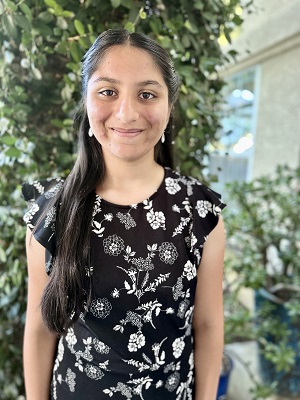
8th Grade, Challenger School – Shawnee
San Jose, CA
Solar-Tracking Litterminator
Project Background: Sharanya has participated in several local city cleanups, but was always saddened to see tons of trash still out there after working hard for hours. “I realized a robot would be able to collect double the amount and work for longer hours,” Sharanya says. Previously, she had also learned that solar panels that move to always face the sun collect more energy than stationary ones. “I really wanted to fix the pollution problem, but I also wanted to fix the inefficient solar panel problem,” she explains. So Sharanya decided to tackle both at once by designing a trash-collecting robot powered by a sun-tracking solar panel.
Tactics and Results: Sharanya’s robot has trash and recycling bins and moves with motorized wheels. The device’s front and back has object-detecting sensors to find trash. One end of the robot has a trash-collecting moveable arm with a pan to scoop objects and dump them into the trash or recycling bins. This pan also contains a metal-detecting sensor to sort metal recyclables into the appropriate place. A solar panel sits at the robot’s other end, extended into the air. Attached to it is a light-tracking device that follows the sun, prompting the solar panel to move accordingly. In tests, the sun-tracking solar panel generated more power than a stationary solar panel over six hours. The robot correctly identified an object every time it was presented, and it picked up items 80 percent of the time. It also correctly classified aluminum cans as recyclables 80 percent of the time. “The trash-collecting robot could benefit our entire world by reducing trash pollution,” Sharanya says.
Other interests: Sharanya enjoys coding, learning new computer languages and attending Hackathons. “I feel undaunted and push myself to create complex programs,” she says. She also likes water polo, chess and playing the Indian Carnatic flute. In the future, she would like to become a surgeon. “I’ve always been interested in the field of medicine because I am passionate about improving peoples’ lives,” she says.
Johan Coisman
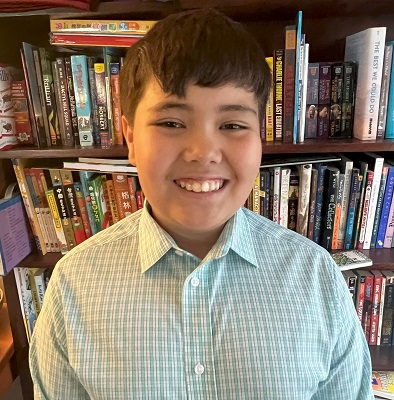
6th Grade, Weston Middle School
Weston, MA
Chilling Out With Marine Cloud Brightening – Artificial Cloud Creation to Cool the Planet
Project Background: “I wanted to work on the biggest problem that I could find, even if my research would only advance science by an inch or two, so I chose global warming,” Johan says. While researching climate solutions, he found a promising technology to combat climate change called marine cloud brightening. It involves creating artificial clouds that reflect radiation from the sun to reduce Earth’s temperature. He designed and tested artificial clouds with different features to see how they could alter the temperature below.
Tactics and Results: Johan first built a plexiglass box to serve as a cloud chamber with a heat lamp at the top to simulate the sun. He generated clouds with a piezo atomizer. It uses ultrasonic vibrations to push water through mesh, turning the liquid into mist. In total, Johan created nine different types of clouds. These involved different combinations of three water droplet sizes and three salt levels. To run a trial, Johan generated a cloud and turned on the heat lamp for 22 seconds. He then recorded the temperature at the bottom of the chamber. Johan performed five trials for each cloud type and a control scenario without a cloud. Clouds with the smallest droplets, 3 micrometers, and the highest salinity, 15 percent, were the best at keeping the environment cool. With this cloud type, the bottom of the chamber’s temperature was, on average, about 73 degrees Fahrenheit, or 23 degrees Celsius. Without a cloud, the chamber was about 77 degrees Fahrenheit, or 25 degrees Celsius. Smaller water droplets are rounder than larger ones, which allows for more refraction of light, Johan says. Salinity increases reflectivity because the salt crystals act like small mirrors, he notes.
Other interests: Johan enjoys viola, soccer and participating in Boy Scouts. He hopes to continue coming up with climate solutions in the future. “There is really only one scientific career for me — climatology,” Johan says. “In this job, you can literally make the lives of every living person (actually, every person who will ever live) better.”
Stephen Cronin
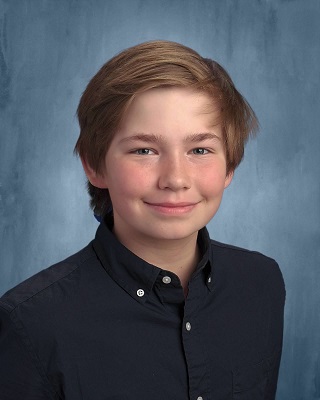
7th Grade, Saint Catherine of Siena Catholic School
Norwood, MA
Glacier Geoengineering
Project Background: “I have been interested in the environment and climate change since I was in elementary school,” Stephen says. During the summers, he often took trips to the Columbus Zoo. The polar bear exhibit shows time-lapse photographs of glaciers melting, Stephen says. “This grabbed my attention and stuck with me.” So he decided to see if a geoengineering approach could slow the melting of ice shelves, the floating ice sheets that border glaciers and polar land masses. Ultimately, he’d like to help preserve Thwaites Glacier, whose collapse could trigger a huge rise in sea level.
Tactics and Results: Stephen thought a flexible curtain surrounding an ice shelf might block incoming warm ocean water, slowing melting. For the experiment, Stephen filled two aquarium tanks with water. Each had an ice block sitting on cinder blocks at one end, and a heater on the other end. He placed thermometers on each side. In the experimental tank, a curtain made of a silicone zip top bag holding sand and air sat in the center. Stephen attached fishing bobbers to make the top float and anchored the curtain in the tank with Command hooks. After turning on the heaters in both tanks, Stephen recorded temperatures every 15 minutes. During the five trials, the control tank’s water temperatures were about the same at both ends while the curtain tank’s water stayed much warmer near the heater. The model ice shelf also melted faster in the control tank in all but one trial. “Building a geoengineered curtain could help buy us more time as the world transitions to renewable energy,” Stephen says.
Other interests: Stephen enjoys playing ice hockey and baseball competitively. “It is a lot to balance with academics,” he says, but it’s worth it. “Athletics has taught me to set goals, stay positive and pursue your dreams.” Stephen hopes to become an environmental engineer. “I like to solve problems using science and math,” he says.
Chloe Svetlana Fierro
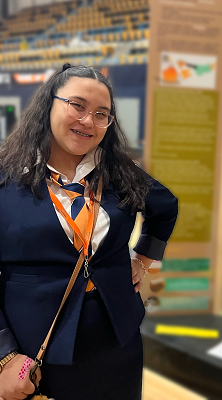
6th Grade, Homeschool
El Paso, TX
Therma-Q: Analyzing the Thermal Performance of a Quercus suber Insulation
Project Background: Last year, Chloe’s family visited the San Diego Botanical Garden. “When we came upon the cork tree, I was amazed to read it had so many good properties,” she says. Those helpful properties include fire and insect resistance, good heat and sound insulation and being renewable. Chloe’s mom, who’s an architect, mentioned that cork was becoming more popular as a product used in buildings. “The thermal properties made me wonder if it was being used as an insulator,” Chloe says. Much to her surprise, she couldn’t find much data on cork’s insulative properties, and noticed that it isn’t widely marketed. Chloe also found that many types of commonly used insulation are made of harmful materials, hard to recycle and contribute to climate change. So she took on the task of measuring cork’s insulative properties to compare the material to other types of insulation.
Tactics and Results: Wall and ceiling insulation helps keep a building’s interior at a comfortable temperature. To test how well cork compared to two commercially-available rigid insulators, Chloe lined the inside of glass terrariums — model houses — with the different materials. She had thermometers measuring temperatures inside and outside the terrariums. To simulate cold weather, Chloe placed them outside and recorded temperatures at the same time, five times a day for 10 days. To model hot weather, she stuck the terrariums in her oven heated to a low temperature. She repeated this for 10 hot day simulations, with five readings per “day.” Averaging the daily temperature readings showed that the cork outperformed both commercial insulators. On average, cork kept the inside of the model house the warmest during cold day simulations, and it kept the inside the coolest during hot day simulations. “The findings of this experiment help us make smarter choices,” Chloe says. Using cork, a sustainable resource, as insulation could help reduce climate change, she notes.
Other interests: Chloe enjoys crafting, playing cello and baking. “I love crafting because I feel there are so many endless possibilities,” she says. Playing the cello also gives her creative freedom. Chloe would like to become a materials scientist. “I can create something with my hands that can potentially solve many problems,” she explains.
Maya Gandhi
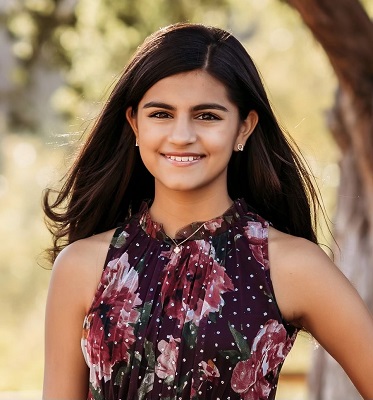
8th Grade, Fairmont Private School – Anaheim Hills Campus
Anaheim, CA
Optimizing Plant Microbial Fuel Cell Energy Output: The Effect of Anodic Substance and Configuration
Project Background: Maya is interested in eco-friendly sources of energy production. “It is concerning that fossil fuels still account for the majority of our world’s energy while being responsible for over 90% of the harmful carbon emissions in our atmosphere,” she says. While researching alternative energy sources, she came across a study exploring plant microbial fuel cells. This technology generates electricity using living plants and bacteria residing in the soil. She decided to explore different substances to use for the fuel cell’s anode, the electrode where electricity flows from, to boost energy output.
Tactics and Results: Maya constructed several plant microbial fuel cells in small plastic containers. First, she put a layer of mud with the bacterium rhizobium. These microbes break down plant waste, and the energy from the chemical reaction gets converted into electrical energy by the fuel cell. Next came the anode layer. Maya tested four options: stainless steel mesh, stainless steel with activated carbon, graphite and carbon copper brush. She made three fuel cells per anode type. After that was the plant roots and surrounding soil, and then a stainless steel mesh cathode. This is the electrode where electricity moves into. She wired up each fuel cell’s cathode to its anode to complete the circuit. Maya ran the experiment for one week and every 12 hours she measured each fuel cell’s voltage output. In the end, the fuel cells with a carbon copper brush anode consistently produced the most electricity. “Given the vast amount of vegetation throughout the world,” Maya says, “plant microbial fuel cell technology has the potential to be an important clean energy source.”
Other interests: “I find great joy in extracurriculars that allow me to enhance and utilize my leadership skills while using my resources to assist those in need,” Maya says. She has led several fundraisers as the president of her school’s National Junior Honors Society. Maya also enjoys her athletic activities, including basketball, Bollywood and hip-hop, where she can collaborate as part of a team. Because of her interest in green energy innovations, Maya hopes to become an environmental engineer.
Shanya Gill
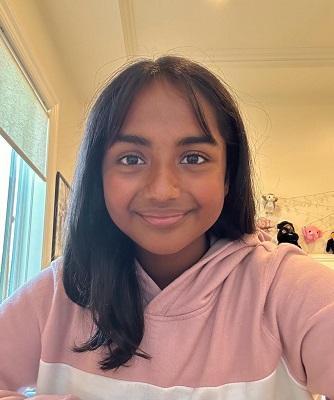
6th Grade, Stratford School – Sunnyvale Raynor Middle School
San Jose, CA
Prevention of Casualties and Property Damage Using Thermal Imaging and Software Based Occupancy Detection
Project Background: In the summer of 2022, a fire destroyed a restaurant behind Shanya’s house. “Since then, my mother became increasingly cautious, always asking me to double-check that the kitchen stove was turned off before leaving our house,” she says. One day, Shanya discovered that thermal cameras can detect heat loss in homes during winter months. She wondered if these cameras could also spot house fires more quickly than traditional smoke detectors. “With an early warning system, we could save thousands of lives every year,” Shanya says.
Tactics and Results: For the fire-detection system, Shanya connected an affordable thermal camera to a tiny computer. She programmed it to detect people as warm objects moving horizontally and heat sources, like a turned-on gas burner, as hot objects that remained still. Shanya also programmed the system to send a text message when it detected a heat source but no humans for 10 minutes. The prototype device was then mounted on the kitchen wall. Shanya conducted multiple trials at various times of day and with people entering the camera’s view from different directions. In the end, Shanya’s system accurately detected human presence 98 percent of the time and heat sources 97 percent of the time. It also sent text messages 97 percent of the time when a heat source was left unattended. With more enhancements, Shanya says, this device could surpass traditional smoke detectors in accuracy, affordability and emergency response time.
Other interests: Shanya enjoys swimming, water polo and table tennis. “I thoroughly enjoy engaging in sports, as it has been a passion of mine since a young age,” she says. She also likes crafting, coding and teaching younger kids. In the future, Shanya hopes to become a biomedical engineer. “By combining my love for biology, desire to make a difference and passion for innovation, biomedical engineering is the perfect fit for me,” she says.
Aiden Grover
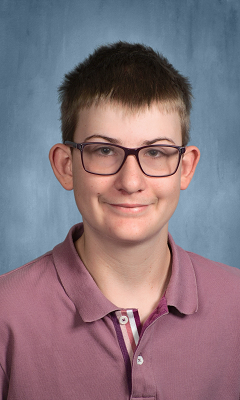
8th Grade, Riverside STEM Academy
Riverside, CA
Decreasing Pickleball Noise
Project Background: One day, Aiden read an article explaining that many people hate pickleball because the game is so loud. “As a pickleball player, I was shocked,” he says. Similar to tennis, players use paddles to whack a ball back and forth over a net. From 100 feet away, about 30 meters, a game’s average noise level is 70 decibels, which is just below a vacuum cleaner. The sounds can annoy nearby communities and distract players, and slightly louder noises can harm hearing over time. “I decided that I would try to do something to make the game quieter, as pickleball is a really fun game to play,” Aiden says, so he designed a quieter ball.
Tactics and Results: Pickleballs are hollow, plastic and filled with holes. Aiden tried plugging the holes with different items to prevent sound from escaping. He also added sound-dampening materials to the outside of some balls and put flexible but rigid materials onto others. He ended up making 19 different prototypes to compare to a standard ball. He then dropped each ball three times from a height of 6.5 feet, or 2 meters. During each trial, Aiden logged how high the ball bounced and the sound from 8 inches, or 20 centimeters, away. He also took audio recordings so he could find each ball’s main sound frequency. The greater the frequency, the higher the pitch to human ears. “Instead of focusing on just one goal, I decided to find the design that was most well rounded,” Aiden says. He found the best solution to be adding flexible but rigid material to the ball’s exterior. That’s because the hard surfaces on the ball and paddle make a colossal sound when they collide. In the end, Aiden’s prototype with soft rubber dots added to its surface worked best. “It bounced just as high as the control did, but it was only 62% as loud,” he says.
Other interests: Besides pickleball, Aiden enjoys playing bassoon in his school band. “I chose it because of the sound it makes and the odd shape of the instrument, as it is long and thin,” he says. He also has a business making custom building block sets, and would eventually like to work at LEGO as a mechanical engineer.
Veronica Howard
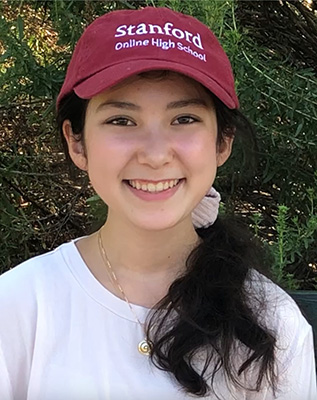
8th Grade, Stanford Online High School
Redwood City, CA
Pesticide Residue on Organic versus Conventional Produce and the Effect of Simple Washing Techniques
Project Background: Veronica’s parents always sought out organic foods. They thought these items had fewer human-made pesticides and were safer to consume. But one day, Veronica and her parents met an inspector for the U.S. Department of Agriculture. She told them that pesticides from conventional farms could reach organic farms if they were located next to one another. “Since then, my parents and I have always wondered if organic produce was actually pesticide-free and if it’s worth spending the extra money,” Veronica says. She investigated whether organic produce has more human-made pesticides than conventional produce, and whether the pesticides could be easily washed off.
Tactics and Results: Veronica tested multiple brands of organic and conventional strawberries and spinach from several stores. These produce items usually contain the highest levels of pesticides, she says. She soaked the foods in distilled water to capture any pesticide residue and then collected samples from the water. She repeated the process with strawberries and spinach that were washed with water alone and water plus dish soap. For a positive control, she made a solution with a human-made pesticide called Orthene, and for negative controls, she collected both tap water and distilled water. She sent all of her water samples to a lab to test them for human-made pesticides. The lab performed an enzyme-linked immunosorbent assay, or ELISA, a sensitive test that can detect certain substances. Veronica worked on a similar project last year but looked for pesticides using a much less sensitive at-home test. The lab results showed that conventional and organic spinach and strawberries had about the same amount of pesticides. Driscoll’s-brand strawberries, however, had more pesticides than the others. But washing them with water decreased pesticide residue by 60 percent. “If consumers wished to save money, they could buy conventional produce and simply wash off any possible pesticide residue,” Veronica says.
Other interests: Veronica recently started archery, “I have found it to be a very interesting sport due to the patience and technique involved,” she says. She also loves playing guitar and performed at her school’s graduation showcase as the lead guitarist in a band. Veronica would like to become an environmental engineer in the future. “I am hoping to find a unique and efficient way to protect our soil and water,” she says.
Akshadha Mehta
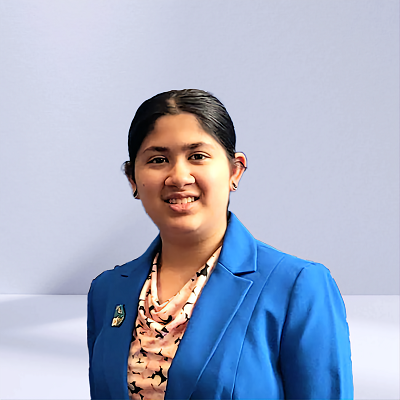
7th Grade, Dodgen Middle School
Marietta, GA
FAP-BRIX: A Practical Solution To Lessen Plastic Pollution
Project Background: “Every time I go to the beaches or trails, I notice that most of all litter would be plastic,” Akshadha says. Plastics are made of non-biodegradable materials and are used all the time. Akshadha read a recent study that estimated nearly 300 million tons of plastic waste are produced each year, and experts predict that number will continue to rise. She also learned that clay and concrete bricks are widely used in the construction industry, but their production is expensive and harmful to the environment. So, Akshadha wanted to solve both problems by turning plastic waste into an alternative type of brick.
Tactics and Results: Akshadha collected materials for her bricks, called fly ash-plastic bricks, or FAP-BRIX, that included fly ash, a byproduct of burning coal, as well as shredded plastic waste, sand, lime and water. She mixed together the materials to make four brick varieties with different proportions of plastic waste and fly ash. She also made bricks with cement instead of plastic waste as a control. Akshadha evaluated many of the bricks’ properties, including their strength, water absorption, heat resistance, weight and density. Bricks take a long time to dry so she tested them on day 7 and day 21. Using equipment at Kennesaw State University, Akshadha found that FAP-BRIX could hold more weight than traditional bricks. “This indicates these bricks are very sturdy,” she says. Her bricks were also about 30 percent lighter than traditional bricks. They did not melt when placed in a furnace that was hotter than 400 degrees Celsius, for 24 hours, and the bricks made of more than 20 percent plastic waste absorbed little water. The materials to produce FAP-BRIX were also less expensive than traditional bricks. Akshadha’s bricks cost $0.30 each, whereas a standard brick costs between $0.50 and $1 each. “FAP-BRIX is a practical solution to lessen plastic pollution,” Akshadha notes.
Other interests: Akshadha likes to dance and swim; she says swimming is “a peaceful form of exercise.” She hopes to become a medical doctor in the future because, “when patients become sick, their normal way of living is changed, but doctors can often bring their routine back,” Akshadha says.
Elizabeth Louise Olvera
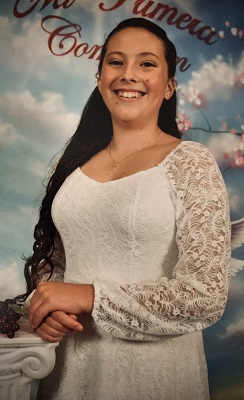
7th Grade, Santa Barbara Charter School HomeBased Partnership
Goleta, CA
Best Natural Fabric for a Reusable Menstrual Pad (Users Can Fabricate)
Project Background: Ellie Lou was inspired by the book and documentary called Period. End of Sentence. It tells the story of women in rural India fighting stigma about menstruation and making their own sanitary pads. “The global community lacks the education and resources needed to manage menstruation,” Ellie Lou says. Although about 25 percent of the world population has periods, surveys suggest more than 50 percent of people with periods cannot access proper menstrual products. These items can also be difficult to dispose of. And m any people, even in the United States, skip class or miss work because they lack access to period products, Ellie Lou says. So she looked into different natural fibers to make affordable reusable menstrual pads.
Tactics and Results: Inexpensive, eco-friendly period products “will empower menstruators to pave their own path towards equity while reducing waste, spending and health risks,” Ellie Lou says. She examined the absorbency of six fabrics made from natural fibers, including bamboo, cotton and hemp. She also tested new versions and used ones taken from upcycled fabric. For each fabric type, Ellie Lou sewed three-layer samples that were 4 square inches, or 10 square centimeters. To test each sample’s absorbency, she weighed it before applying 10 milliliters, or about 0.3 fluid ounces, of water on top. One minute later, she used a different material to re-absorb any lingering liquid on the sample. Ellie Lou then weighed both the sample in question and her re-absorbent material. After testing each sample three times, she found that the fabric made of a cotton and hemp blend was the most absorbent. The aged fabrics also worked better than their newer counterparts.
Other interests: “My absolute passion is being in the water, especially the open ocean,” Ellie Lou says. She enjoys swimming, snorkeling, kayaking, surfing and — most of all — free diving. She wants to be an environmental engineer. “A career in environmental engineering offers a variety of occupations that use science to bridge human needs and wants with the stewardship of nature,” Ellie Lou explains.
Venice Parnell
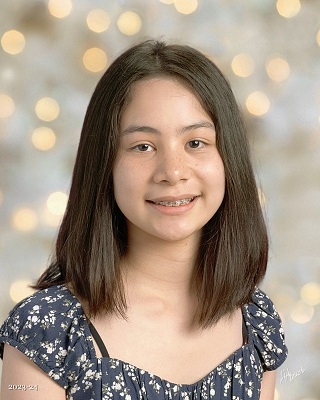
8th Grade, The Harker School
San Jose, CA
The Future of Fashion and Functionality: Transforming Produce Waste and Lignocellulosic Fibers Into Sustainable Vegan Leather
Project Background: While surveying her house, Venice noticed that several items were made of leather. But, she says, “after researching online, I became aware of the harmful impact of cow leather.” Venice also learned that many vegan leathers do not break down easily in the environment, and their production requires fossil fuels. She and her teammate, Claire Xu, decided to explore whether food scraps could be used to make an all-natural leather alternative. “I could address not only the environmental impact of leather production but also contribute to reducing food waste,” Venice says.
Tactics and Results: Venice and Claire explored leather made with four different high-fiber produce items: pineapple, mango, celery and avocado. They combined the fresh produce fibers with other materials including beeswax, glycerin and various amounts of recycled paper. The paper added processed fibers. After mixing the materials together, the students baked each leather sheet in an oven until dry. When finished, Claire and Venice measured the leathers’ thickness and tested how much weight it could hold. They also tested each material’s ability to repel water by examining a water droplet’s shape when placed on the leather. Based on these measurements, the duo found that vegan leather made with celery performed the best overall. It had the smoothest texture, too. They also found that the best ratio of fibers was three parts produce fibers to four parts recycled fibers. The celery leather made with this fiber ratio repelled water better than real leather and was almost as strong. Using this vegan leather prototype, Claire and Venice crafted jewelry, wallets and even the roof of a cat house. “By replacing leather products in the current market with celery leather, we can tap into the growing demand for sustainable and cruelty-free alternatives,” Venice says.
Other interests: Venice enjoys playing piano and flute. One memorable moment was performing “The March of the Nutcracker” with an orchestra. “I’m invigorated by the harmonious blend of instruments and the shared passion of my fellow musicians,” she says. “The feeling of collaborating and unity is indescribable.” Venice would like to become a veterinarian in the future.
Kinnoree Rabeya Pasha
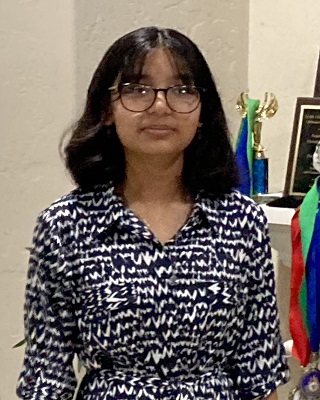
8th Grade, Granite Ridge Intermediate School
Fresno, CA
Analyze the Effects of Soil Management Practice on Water Holding Capacity of Soil To Reduce Water Application and Increase Crop Yield Using Precision Agriculture Technology
Project Background: Kinnoree enjoys helping her dad tend to their vegetable garden at home. “But while doing so for the last few years, I noticed it needed a lot of water for irrigation,” she says. She read about the increasing water shortage, which is especially bad in her home state of California. “Is there any way to optimize water use by improving soil’s ability to hold water?” Kinnoree wondered. So she created an automated irrigation system and changed the soil’s components to see if she could save water.
Tactics and Results: In her family’s home garden, Kinnoree set up three small plots to grow winter spinach. Each contained a moisture sensor in the soil. In the control plot, Kinnoree manually watered the plants, basing the amount on published research. In the two other plots, she set up automated irrigation systems. They watered the plants when soil moisture dropped below 40 percent and stopped when it reached 48 percent. One of these experimental plots also contained biochar. This material comes from burning organic waste material, and it improves soil’s water holding capacity and nutrient retention. Kinnoree found that the plot with the automated irrigation system used 13.4 percent less water on a weekly basis compared to the control. With both the irrigation and biochar, the plants used 27.1 percent less water per week than the control plot. Kinnoree also calculated that biochar alone would need 15.8 percent less water per week than the control. She also measured plant height, diameter and number of leaves per plant throughout the experiment. These metrics showed that her experimental plots’ plants were healthier than the control plots’. “My research can benefit growers in California and around the world,” Kinnoree says.
Other interests: Kinnoree likes to dance and play violin and piano. She’s been learning the classical Indian dance Bharatanatyam since she was nine years old. “This dance helps me express myself through my body, while finding a connection to the roots of my ancestors,” she says. Kinnoree would like to become an ophthalmologist to help people with their vision.
Maan Mamta-Sanjay Patel
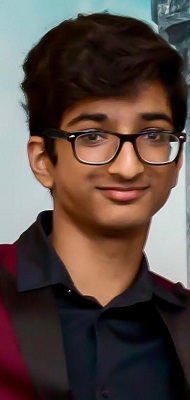
7th Grade, McCullough Junior High School
The Woodlands, TX
Nature’s Super Shapes: How Voronoi Tessellations Affect Structural Strength
Project Background: “In my family, we bike a lot,” Maan says. “And one thing that is always on our parents’ minds is safety.” But he was surprised to learn that in the United States, over 130,000 cyclists are injured and 1,000 are killed each year. Often, it’s due to weak or faulty safety gear. That hit close to home for Maan because a helmet saved his dad’s life during a skiing accident a few years ago. Maan thought turtle shells resembled helmets and found that the shells’ scales are organized in specific mathematical arrangements. Called Voronoi patterns, these divide a surface into specific shapes that form around pre-determined points. Since they often make structures stronger, Maan thought Voronoi patterns might make sturdier, lighter helmets.
Tactics and Results: Maan first designed bike helmets with repeated patterns of hexagonal, square or triangular cutouts. He then created clay versions of the helmets that were 12.7 centimeters, or 5 inches, in diameter. He also made control helmets with no cutouts. To test their strength, Maan dropped 10 of each helmet design with their open side facing up. He recorded how many pieces the helmets broke into and found that the one with hexagonal tessellations performed the best. On average, helmets with cutouts of this shape broke into 2.8 pieces. Control helmets, on the other hand, broke into 6.1 pieces on average. And helmets with square cutouts shattered into even more pieces. “This suggests that hexagonal tessellations increase the amount of force necessary to break a helmet, improving its overall safety and strength,” Maan says.
Other interests: Maan enjoys several extra-curricular activities, including tennis, piano, Science Bowl and martial arts. Overall, he loves to compete. “Competing to me is a wonderful sport,” he says, “yes because of the glory of winning, but also because I can learn even more and improve my skills.” Science has always been Maan’s favorite class, so he’d like to become a science teacher one day.
Tate D. Plohr
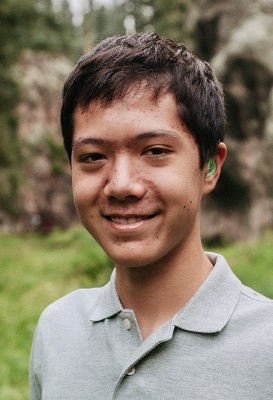
8th Grade, Los Alamos Middle School
Los Alamos, NM
The Stability of Solar Flares
Project Background: For the past few years, Tate has attended public lectures at a local nature center. One of them was about the sun. “I found out that the aurora borealis is actually a solar magnetic storm interacting with the Earth’s magnetic field,” Tate says. He wanted to know how solar flares could extend all the way to Earth’s atmosphere. These flares consist of plasma pushing out of the surface of the sun. Sometimes they can form coronal mass ejections, Tate says, which involves “big blobs of high-energy plasma that spew out in a random direction.” But when they hit Earth’s atmosphere, they can damage electrical systems, disrupt communications and even endanger lives. Tate examined factors that change solar flares’ stability by modelling them on a computer.
Tactics and Results: A common way to simulate a solar flare on a computer is with a magnetic flux rope, or MFR. It’s a theoretical long tube of plasma with magnetic field lines twisting around it, Tate says. These lines represent the direction of a magnet’s force. For simplicity, Tate assumed his MFR had cylindrical symmetry, meaning it was the same down the entire length of the tube and around the tube. One at a time, he altered five variables that affect an MFR, including density and pressure, to different degrees using mathematical equations. He wrote a Python program to solve the equations. For each trial, he measured the mass inside the MFR made with his perturbation added. Some variables changed the mass more than others. Altering the density or magnetic field running along the length of the tube had a big effect, whereas changing velocity or magnetic field wrapping around the tube did little. “I concluded that MFRs are stable but can gain or lose mass due to a perturbation,” Tate says. “This means after a series of perturbations, a solar flare can either grow tremendously or shrink to a miniscule size.”
Other interests: Tate enjoys learning advanced mathematics and playing tennis. He also loves music, especially playing piano. “I find that playing piano is very calming and helps me focus when I have a lot to do,” he says. Tate hopes to become an astrophysicist and study plasma. “Plasma physics is a very cutting-edge, future-career topic, and I am very, very interested in it!” he says.
Nikita Prabhakar
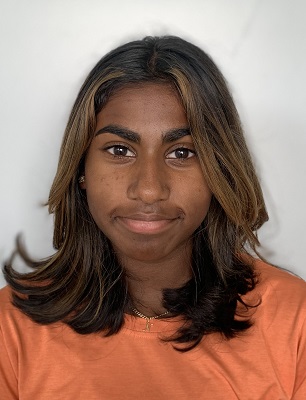
7th Grade, Discovery Middle School
Madison, AL
A Non-Invasive Integrated Sensor for Monitoring Menorrhagia
Project Background: One day, Nikita’s family friend talked about her experiences with endometriosis. It’s a painful disease where tissue similar to that which lines the uterus grows where it shouldn’t. Curious about the condition, Nikita researched it. She found that endometriosis can also cause excessive menstrual bleeding, called menorrhagia. To her surprise, doctors rely on questionnaires and pictorial charts to figure out period blood loss volume. This can be subjective and inaccurate, Nikita says. “I then came up with the idea of integrating sensors with sanitary pads that can automatically measure the actual blood loss.”
Tactics and Results: Nikita designed and 3-D printed weight sensors that could be placed inside a sanitary pad and track data in real time. Her first sensor design was 47 millimeters long, 12 millimeters wide and 6 millimeters tall, or about 2 inches by 0.5 inch by 0.25 inch. She wired up the sensors to a computer, where a software would convert the weight readings to fluid volume. But these sensors ended up being too large to comfortably sit in a pad. So, Nikita instead connected two tiny sensors, each 0.3 millimeters thick and 8 millimeters in diameter. That’s about 0.01 inches tall and 0.3 inches wide. These could easily be mounted inside a pad and hooked up to the same circuit. Nikita found that the sensors were highly accurate at detecting fluid volume when she added simulated blood. The readings were within 1 percent error compared to weight shown when measured with a scale. This project, Nikita says, “has great potential for diagnosing and treating menorrhagia, bringing relief to millions of women.”
Other interests: Nikita enjoys playing tennis and violin and participating in Scholar’s Bowl and math team. She also likes being the driver of her Greenpower racing team, which builds and races electric cars. In the future, Nikita hopes to be a surgeon. “With the new generation of robotic instruments, treatments and artificial organs,” she says, “I am excited to be part of the future.”
Amritha Praveen
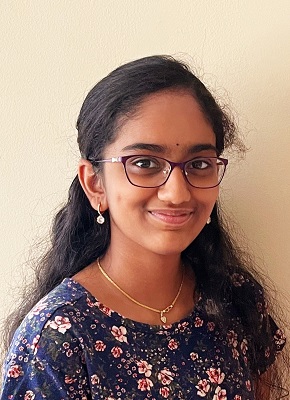
8th Grade, Aptakisic Junior High School
Buffalo Grove, IL
Improving Mental Health Using Artificial Intelligence-Powered Music Therapy
Project Background: “As I play different styles of music, I have experienced the different emotional responses evoked,” Amritha says. She plays several instruments. And her brother has received music therapy, an approach to treating mental health conditions. But Amritha noticed there was no way to measure the effectiveness of this therapy or provide any feedback if the music is helping or not. “This motivated me to develop a recommendation model that used physiological signals as feedback,” Amritha says. She decided to create a system that measures bodily responses, like heart rate, in real time to find the most effective music for an individual’s music therapy.
Tactics and Results: Amritha first determined which musical features, like pitch and range, contributed most to physiological signs of relaxation. Those signs include lowered electrical activity in the skin — a measure of sweat gland activity — and reduced heart rate. She then built a music library and recommendation system software that could filter content based on the important musical features. She hooked up sensors that detect a music listener’s skin and heart’s responses. If these signals suggest the listener is relaxed, the software finds similar music. If not, it tries different music. To test the system, Amritha recruited 20 teenage volunteers. She recorded their baseline heart rate and skin electrical activity, then had them listen to music with the physiological feedback, without feedback and no music. Amritha consistently recorded lower heart rate and skin electrical activity when using the feedback system compared with the other two session types. During feedback sessions, there was also a big difference between physiological measurements taken at the beginning versus at the end. “Music can be used deliberately to regulate our emotions,” Amritha says. “However, music is also very abstract, and it is interesting to study the correlation between musical features and physiological responses.”
Other interests: Amritha enjoys math and playing the piano, viola and veena, a string instrument that originates from India. With the veena, she says, “the strings mimic the human voice when played skillfully.” Amritha would like to become a neurologist in the future. “I envision a career path where I can apply my mathematical skills to advance the field of neurology and provide assistance and support to those in need.”
Aswath Rajesh
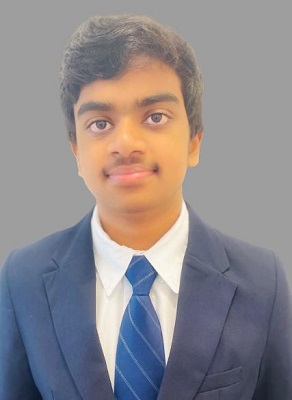
8th Grade, DeLaura Middle School
Satellite Beach, FL
Ecofriendly Polymeric Material: Paving the Way for Circular Bio-Economy
Project Background: “Plastics take centuries to biodegrade, and they end up in oceans, rivers and landfills,” Aswath says. “After discovering the detrimental effects caused by plastics, I was motivated to find a solution for plastic pollution.” He searched for eco-friendly alternatives and discovered that plastics can be made of either human-made or naturally occurring polymers, chains of molecules. Natural polymers, like starch, break down more easily in the environment than synthetic ones. Many can also be found in products considered waste. So, Aswath decided to make a biodegradable plastic with chitosan, a substance that comes from the shells of crustaceans like crab, shrimp and lobster. Aswath worked on improving the water resistance of a plastic alternative he previously developed.
Tactics and Results: Aswath made several bioplastics that contained three natural polymers: starch from rice flour, cellulose from newspaper and chitosan from seafood waste. His bioplastics contained different amounts of chitosan, and a control that contained none. Once created, he tested the seven bioplastics’ properties. Aswath pulled on the bioplastics with a gauge to measure their tensile strength, submerged them in water for water resistance, folded them to test flexibility and put them in soil to see how quickly they biodegraded. The bioplastics with chitosan were less flexible and broke down more slowly than the control. But the bioplastic made of 60% chitosan, the highest amount, had 50% greater tensile strength and was 40% more water resistant compared to the bioplastic with no chitosan. The properties also change depending on how much chitosan is included. So, varying the amount can create bioplastics that meet different needs, Aswath says. He also notes that “by redirecting waste from landfills, it enables the utilization of valuable resources that would otherwise go to waste.”
Other interests: Aswath enjoys piano, guitar, soccer, tennis and taekwondo but he especially loves playing chess. “The game’s strategic nature keeps me engaged and tests my thinking abilities,” he says. “I have to concentrate, think strategically and predict my opponent’s moves.” He would like to become an environmental engineer to help build a better future.
Nyambura Sallinen
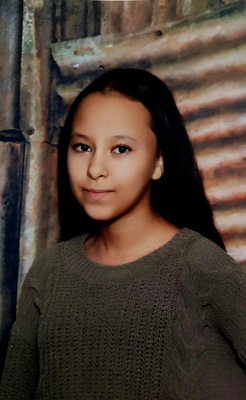
8th Grade, Lanier Middle School
Sugar Hill, GA
IdentiCan: The App That Detects Breast, Lung and Skin Cancer
Project Background: “Cancer is a huge problem in our world that has touched millions of lives,” Nyambura says. Her own friends and family members have been affected by cancer, she notes. Nyambura is also interested in going into the medical field so she and her teammate, Keshvee Sekhda, started looking into how artificial intelligence might help. They soon learned how crucial it has become in society and how much it can accomplish. “We automatically knew that we want to combat this problem by using these modern advancements,” Nyambura says.
Tactics and Results: Nyambura and Keshvee developed a mobile app prototype called IdentiCan to identify breast, lung and skin cancer. They trained a machine learning algorithm to recognize these cancers using more than 8,000 photos and health scan images of each cancer type. For lung cancer, the teammates also included audio clips of people with cancer and other respiratory diseases so the algorithm could learn to tell the difference. The system also accounts for family history, medical history and other relevant health information. Within the app, a user would be able to upload their information, images and sound clips, and it will return the likelihood of them having cancer. When testing several sample trials simulating a user, IdentiCan accurately identified cancer 94.3 percent of the time. “In the future, Nyambura says they want to “collect more feedback from… professionals and hospitals,” and hopes to one day be able to legally test their app with humans.
Other interests: Nyambura enjoys piano, violin, robotics and soccer. But her favorite hobby is dance, “Dancing has always been a passion for me,” she says. “What I truly love is that you get to tell a story through your movements.” She hopes to become a neurosurgeon one day. “I find how the brain functions really intriguing,” Nyambura says.
Mikolas Schwickert
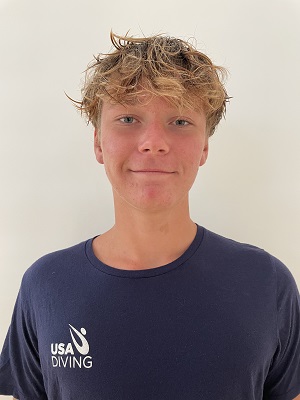
8th Grade, Arizona Virtual Academy
Glendale, AZ
Aerosol Whip Cream Nozzles: Engineering and Optimization of Nozzles for Least Overspray
Project Background: “Every time I use a store-bought whipped cream canister, I have to clean up a huge mess,” Mik says. The whipped cream flies everywhere, he notes. But on a recent trip to Germany, Mik noticed that dispensing whipped cream wasn’t quite as messy as back home. He saw that German canister nozzles had a dome at the top. But the nozzles in the United States are straight and lack this structure. “I wanted to investigate if I can design a nozzle shape that would reduce the mess of whipped cream outside my plate,” Mik says.
Tactics and Results: Mik 3-D printed more than 10 different nozzle designs. One by one, he attached them to a canister full of cream with a cartridge of nitrous oxide. This gas sprays the cream and fills it with bubbles, making it fluffy. Mik built an apparatus to hold the whipped cream canister and dispense it for a specified amount of time. Using this, he tested each nozzle design 10 times to see how much whipped cream sprayed outside a 4.5-inch-by-6-inch rectangular area, or 11.2 centimeters by 15 centimeters. The reverse Venturi nozzle, which has thinner ends and a wider, barrel-shaped center, performed the best. It consistently kept the whipped cream inside of Mik’s target area, with no overspray. Four other designs sprayed less than 1 percent of the whipped cream outside the area. “Slowing down the whipped cream, reducing its velocity, is the most important factor,” Mik says.
Other interests: Mik competes as an artistic swimmer and diver. One day, he says, “I hope to dive on the same boards and compete against Andrew Capobianco, an Olympic diver.” He would like to become a pilot in the future. “I know every single airplane in the sky, how fast they fly, what features they have,” Mik says.
Keshvee Sekhda
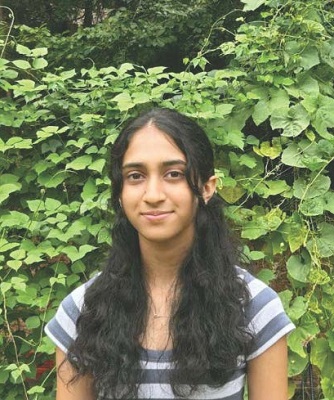
8th Grade, North Gwinnett Middle School
Sugar Hill, GA
IdentiCan: The App That Detects Breast, Lung and Skin Cancer
Project Background: Keshvee has heard several stories of people within her community who received late cancer diagnoses. One that stuck with her was about a man’s father. When he first went to a hospital for discomfort, he was misdiagnosed. But the man later returned after still feeling something was off and was diagnosed with an aggressive brain tumor. “This man was only given a few months to live due to the mistake in interpreting earlier scans,” Keshvee says. “My partner and I decided that we must do something to help people scan themselves and get the attention they need.”
Tactics and Results: Keshvee and her teammate Nyambura Sallinen developed a mobile app prototype called IdentiCan to identify breast, lung and skin cancer. They trained a machine learning algorithm to recognize these cancers using more than 8,000 photos and health scan images of each cancer type. For lung cancer, the teammates also included audio clips of people with cancer and other respiratory diseases so the algorithm could learn to tell the difference. The system also accounts for family history, medical history and other relevant health information. Within the app, a user would be able to upload their information, images and sound clips, and it will return the likelihood of them having cancer. When testing several sample trials simulating a user, IdentiCan accurately identified cancer 94.3 percent of the time. “The next step would be to collaborate with professional doctors. . . to receive a different view on our app,” Keshvee says.
Other interests: Out of all her hobbies, Keshvee’s favorites are soccer and robotics. “Being involved in robotics competitions is a great source of fun and challenges,” she says. “Soccer has allowed me to be active and push myself to stand out and be the best team player I can be on the field.” She hopes to become a neurosurgeon in the future so she can help save lives.
Elizabeth Shen
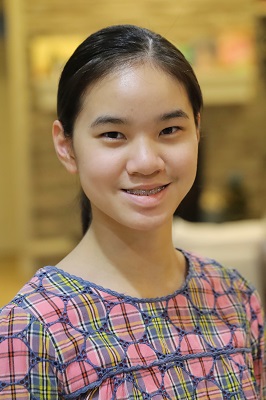
8th Grade, Stoller Middle School
Portland, OR
Diffusion-Only Water Transport and How to Modulate Its Speed
Project Background: Oil pollution is a big problem. Removing it from water is vital for the environment, Elizabeth says. “I believe physical absorption is the quickest and most cost-effective method,” she notes “And the core of absorption is diffusion.” Diffusion occurs when molecules spread out, moving from an area highly concentrated with molecules to an area with a lower concentration. Elizabeth came up with a low-cost method to determine water’s rate of diffusion, or diffusivity.
Tactics and Results: Elizabeth designed an apparatus that holds a single paper towel by the edges so that it’s flat and parallel to the ground. That way she could measure how water spread across the paper towel without gravity interfering. Elizabeth let water seep into the paper towel from one end and measured how far the waterline traveled at various time points. She repeated the process with water at different temperatures. By adapting an equation that calculates heat transfer, Elizabeth figured out the water’s diffusivity. As temperature increased, so did diffusivity. Figuring out how water moved from one side of the paper towel to the other also helped her design different paper towel shapes that changed water’s diffusion speed. A tall, thin hourglass-like shape increased speed, Elizabeth says. But a shape with a larger center and narrower ends reduced speed. “Knowing diffusivity can help predict the movement of substances through a material and identify material properties,” she says.
Other interests: Elizabeth enjoys playing piano and violin, writing and the board game Go. She would like to become a neurosurgeon and neuroscientist because she’s fascinated by the brain. “I have often wondered how one organ can enable such thoughts, emotions and creativity,” she says.
Claire Xu
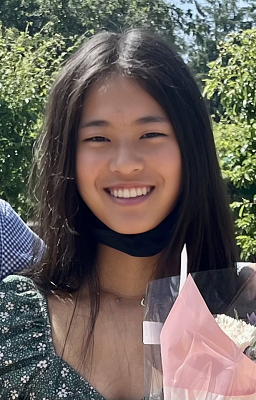
8th Grade, The Harker School
San Jose, CA
The Future of Fashion and Functionality: Transforming Produce Waste and Lignocellulosic Fibers Into Sustainable Vegan Leather
Project Background: Claire learned in science class that people in the United States discard 119 billion pounds, nearly 54 million metric tons, of food every year. This waste generates greenhouse gases, contributing to climate change. Another process that damages the environment is leather production. Although synthetic and plant-based leathers are less harmful, Claire found that their production uses fossil fuels and plastics. And some leather alternatives do not biodegrade easily. So, she and her teammate Venice Parnell decided to see if they could use food scraps to create vegan leather. The fashion industry and the planet will benefit from this environmentally friendly leather alternative, Claire says.
Tactics and Results: Claire and Venice explored leather made with four different high-fiber produce items: pineapple, mango, celery and avocado. They combined the fresh produce fibers with other materials including beeswax, glycerin and various amounts of recycled paper. The paper added processed fibers. After mixing the materials together, the students baked each leather sheet in an oven until dry. When finished, Claire and Venice measured the leathers’ thickness and tested how much weight it could hold. They also tested each material’s ability to repel water by examining a water droplet’s shape when placed on the leather. Based on these measurements, the duo found that vegan leather made with celery performed the best overall. It looked the nicest as well. “The celery leathers have a smoother texture, which enhances the overall appearance,” Claire says. The pair also found that the best ratio of fibers was three parts produce fibers to four parts recycled fibers. “It enhances durability but still maintains flexibility,” Claire notes. The celery leather made with this fiber ratio repelled water better than real leather and was almost as strong. Using this vegan leather prototype, Claire and Venice crafted jewelry, wallets and even the roof of a cat house.
Other interests: Claire enjoys tennis, reading research papers and lab dissections. “Precision is required in dissections, and I also learn about the complexity of different organisms through interactive and hands-on learning,” she notes. Claire would like to become a biomedical engineer. “I am captivated by the potential of technology advancements to save the lives of many people,” she says.
Rayyan Yaqoob
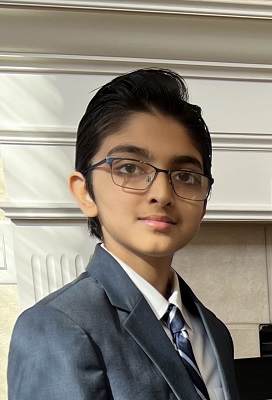
7th Grade, Good Tree Academy
Plano, TX
The Effect of Targeting Multiple Neural Pathways Using Nutraceuticals on the Cognition of Drosophila Melanogaster: A Novel Multi-Target Approach Using Curcumin, Magnesium, and Coenzyme Q10
Project Background: Sadly, Rayyan’s grandfather died of complications from Alzheimer’s disease, a form of dementia. Ever since, he says, “I’ve always wanted to contribute and help people with the condition.” He decided to see if nutraceuticals could boost cognition and slow its decline from aging and dementia. Nutraceuticals are substances derived from foods and might have health benefits beyond their nutritional value.
Tactics and Results: For the experiment, Rayyan studied fruit flies by feeding them special diets. He gave some of them aluminum chloride, which caused cognitive problems to simulate dementia. He also tested various combinations of three nutraceuticals — curcumin, magnesium chloride and coenzyme Q10 — in both aluminum-fed flies and normal-diet flies. These nutraceuticals might aid biochemical pathways involved in learning. After providing these diets for about a week, he studied the fruit flies’ movement, learning, memory and survival over the next three weeks using lab equipment at the University of Texas at Dallas. The normal-diet flies given coenzyme Q10 performed the best in short-term memory tests. And those given magnesium were better at long-term memory tests than the other flies. In fruit flies with aluminum toxicity, those fed all three nutraceuticals had better learning and memory than the impaired flies not given any nutraceuticals. These substances, Rayyan says, could unlock therapeutic potential in people with impaired memory.
Other interests: Rayyan enjoys several extracurricular activities, including student council, science club, soccer, basketball and volunteering at a refugee center. He hopes to become a biomedical engineer. “Biomedical engineering is playing a big role in addressing global health challenges,” Rayyan says. “I think the ability to positively impact communities is greatly rewarding.”
